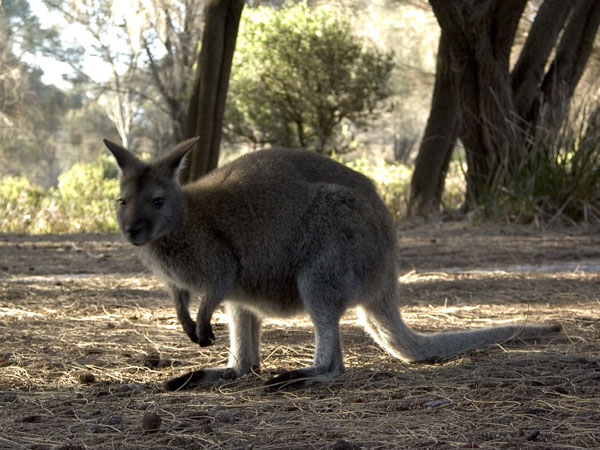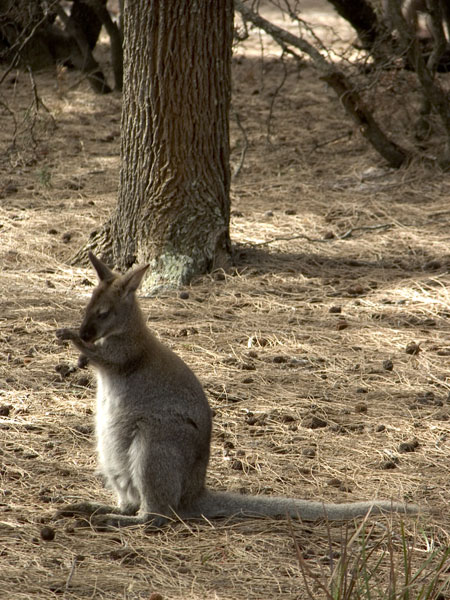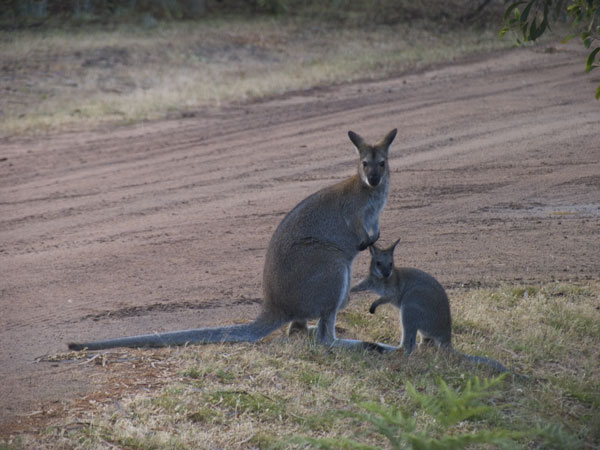 Macropus
rufogriseus
Macropus
rufogriseusRed-Necked Wallaby

 ::
Adaptations
::
Adaptations
What ways have the Wallaby Adapted?
The Red-necked Wallaby has two very important adaptation as to how this organism moves. They include their hind legs and their muscular tail. They
have two large hind legs that aid them in jumping, which
is there main mode of transportation. The hind legs has
elastic tendons in them which help them to spring back
up once they hit the ground. They do however
use all four limbs when moving quickly. The Wallaby is
able to move at speeds up to 64 km per hour! The hind feet has two
nails that are partially fused together, used for combing their fur.
Their forearms not only are for moving, but they are
hand-like and used to manipulate objects. The other
important key to moving is their tail. They have a
large, long muscular tail that assists them in jumping.
It is also used as a prop when sitting up or on all
fours, it is important for balance.
organism moves. They include their hind legs and their muscular tail. They
have two large hind legs that aid them in jumping, which
is there main mode of transportation. The hind legs has
elastic tendons in them which help them to spring back
up once they hit the ground. They do however
use all four limbs when moving quickly. The Wallaby is
able to move at speeds up to 64 km per hour! The hind feet has two
nails that are partially fused together, used for combing their fur.
Their forearms not only are for moving, but they are
hand-like and used to manipulate objects. The other
important key to moving is their tail. They have a
large, long muscular tail that assists them in jumping.
It is also used as a prop when sitting up or on all
fours, it is important for balance.
The teeth of the wallaby are another unique adaptation. The molars erupt one after another and they progressively move forward in the jaw. Once the premolars are worn down they are lost and the first molars move forward into their spot. When the first molars are lost the second molars move into their spot. They have four molars in each jaw. Age of a wallaby can often be determined by looking at the teeth and the movement of the teeth in the jaw. Also the incisors can move and act as scissors in a ripping motion, for more information on the incisors see Nutrition.

The Red-necked Wallaby can often be seen licking their hands and forearms. This is done when it is warm outside, it released body heat. They are also able to retain water by reabsorbing urea in the kidneys, this is also important for when it is dry and water is in shortage.
All though wallabies are not hunters and don't need to find animals they do need to sense their environment and react to stimuli such as danger. They do this by acute hearing. Wallabies have pretty poor eye sight, but through hearing they are able to sense and respond to their surrounding.

Check out what they eat!!
The Red-necked Wallaby has two very important adaptation as to how this
 organism moves. They include their hind legs and their muscular tail. They
have two large hind legs that aid them in jumping, which
is there main mode of transportation. The hind legs has
elastic tendons in them which help them to spring back
up once they hit the ground. They do however
use all four limbs when moving quickly. The Wallaby is
able to move at speeds up to 64 km per hour! The hind feet has two
nails that are partially fused together, used for combing their fur.
Their forearms not only are for moving, but they are
hand-like and used to manipulate objects. The other
important key to moving is their tail. They have a
large, long muscular tail that assists them in jumping.
It is also used as a prop when sitting up or on all
fours, it is important for balance.
organism moves. They include their hind legs and their muscular tail. They
have two large hind legs that aid them in jumping, which
is there main mode of transportation. The hind legs has
elastic tendons in them which help them to spring back
up once they hit the ground. They do however
use all four limbs when moving quickly. The Wallaby is
able to move at speeds up to 64 km per hour! The hind feet has two
nails that are partially fused together, used for combing their fur.
Their forearms not only are for moving, but they are
hand-like and used to manipulate objects. The other
important key to moving is their tail. They have a
large, long muscular tail that assists them in jumping.
It is also used as a prop when sitting up or on all
fours, it is important for balance.The teeth of the wallaby are another unique adaptation. The molars erupt one after another and they progressively move forward in the jaw. Once the premolars are worn down they are lost and the first molars move forward into their spot. When the first molars are lost the second molars move into their spot. They have four molars in each jaw. Age of a wallaby can often be determined by looking at the teeth and the movement of the teeth in the jaw. Also the incisors can move and act as scissors in a ripping motion, for more information on the incisors see Nutrition.

The Red-necked Wallaby can often be seen licking their hands and forearms. This is done when it is warm outside, it released body heat. They are also able to retain water by reabsorbing urea in the kidneys, this is also important for when it is dry and water is in shortage.
All though wallabies are not hunters and don't need to find animals they do need to sense their environment and react to stimuli such as danger. They do this by acute hearing. Wallabies have pretty poor eye sight, but through hearing they are able to sense and respond to their surrounding.

Check out what they eat!!





